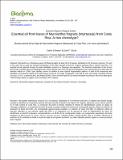| dc.creator | Chaverri Chaverri, Carlos | |
| dc.creator | Cicció Alberti, José Francisco | |
| dc.date.accessioned | 2019-10-03T15:27:12Z | |
| dc.date.available | 2019-10-03T15:27:12Z | |
| dc.date.issued | 2017 | |
| dc.identifier.citation | https://www.blacpma.usach.cl/revista-numero/essential-oil-leaves-myrcianthes-fragrans-myrtaceae-costa-rica-new-chemotype | |
| dc.identifier.issn | 0717-7917 | |
| dc.identifier.uri | https://hdl.handle.net/10669/79303 | |
| dc.description.abstract | Myrcianthes is a Myrtaceous genus of flowering plants of about 30 to 40 species, distributed in the American continent. The aim of this work was to study the chemical composition of the foliar essential oil from M. fragrans growing wild in central Costa Rica. The essential oil was obtained through the steam distillation process in a Clevenger type apparatus. The chemical composition of the oil was performed by capillary gas chromatography with a flame detector (GC-FID) and gas chromatography-mass spectrometry (GC-MS) using the retention indices on a DB-5 type capillary column in addition to mass spectral fragmentation patterns. A total of 98 compounds were identified, accounting for 98.8% of the total amount of the oil. The major constituents in the leaf oil were (E)-methyl cinnamate (39.6%), limonene (34.6%), α-pinene (6.8%), and linalool (6.8%). This is the first report of (E)-methyl cinnamate occurring in oils of this plant genus. These findings appear to suggest a new chemotype of M. fragrans. | es_ES |
| dc.description.abstract | Myrcianthes (Myrtaceae) consta de 30 a 40 especies, distribuidas en el continente americano. El objetivo del presente trabajo consistió en identificar la composición química del aceite esencial contenido en las hojas de M. fragrans, planta que crece en forma silvestre en el Valle Central de Costa Rica. La extracción del aceite se efectuó mediante el método de hidrodestilación usando un equipo de Clevenger modificado. La composición química del aceite se analizó mediante las técnicas de cromatografía gaseoso-líquida con detector de ionización de llama (GC-FID) y de cromatografía gaseoso-líquida acoplada a un detector de masas (GC-MS). Se utilizaron índices de retención obtenidos en una columna capilar tipo DB-5 y se compararon con los patrones de iones de fragmentación de masas. Se identificaron en total 98 compuestos, correspondientes a un 98.8% de los constituyentes totales. Los componentes mayoritarios del aceite resultaron ser (E)-cinamato de metilo (39.6%), limoneno (34.6%), α-pineno (6.8%) y linalol (6.8%). Este es el primer informe de la aparición de (E)-cinamato de metilo en aceite de hojas de este género de plantas. Los datos obtenidos parecen sugerir un nuevo quimiotipo de M. fragrans. | es_ES |
| dc.description.sponsorship | Universidad de Costa Rica/[]/UCR/Costa Rica | es_ES |
| dc.language.iso | en_US | es_ES |
| dc.source | Boletín latinoamericano y del Caribe de plantas medicinales y aromáticas, vol.16(4), pp.385-397 | es_ES |
| dc.subject | Myrcianthes fragrans | es_ES |
| dc.subject | Myrtaceae | es_ES |
| dc.subject | Essential oil | es_ES |
| dc.subject | (E)-methyl cinnamate | es_ES |
| dc.subject | Limonene | es_ES |
| dc.subject | Chemotype | es_ES |
| dc.subject | Aceite esencial | es_ES |
| dc.subject | (E)-cinamato de metilo | es_ES |
| dc.subject | Limoneno | es_ES |
| dc.subject | Quimiotipo | es_ES |
| dc.title | Essential oil from leaves of Myrcianthes fragrans (Myrtaceae) from Costa Rica. A new chemotype? | es_ES |
| dc.title.alternative | Aceite esencial de las hojas de Myrcianthes fragrans (Myrtaceae) de Costa Rica. ¿Un nuevo quimiotipo? | es_ES |
| dc.type | artículo original | |
| dc.description.procedence | UCR::Vicerrectoría de Docencia::Ciencias Básicas::Facultad de Ciencias::Escuela de Química | es_ES |
| dc.description.procedence | UCR::Vicerrectoría de Investigación::Unidades de Investigación::Ciencias Básicas::Centro de Investigaciones en Productos Naturales (CIPRONA) | es_ES |


